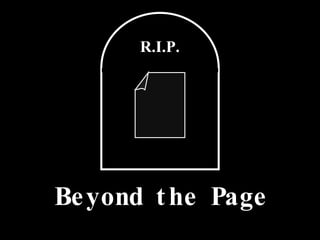Beyond the Page
•Download as PPT, PDF•
40 likes•1,858 views
Presentation from IA Summit '05.
Report
Share
Report
Share

Recommended
More Related Content
What's hot
What's hot (20)
Designing Powerful Web Applications Using AJAX and Other RIAs

Designing Powerful Web Applications Using AJAX and Other RIAs
Using Web 2.0 Principles to Become Librarian 2.0: Overview

Using Web 2.0 Principles to Become Librarian 2.0: Overview
Viewers also liked
Viewers also liked (12)
Yes, My Iguana Loves to Cha-Cha: Improv, Creativity and Collaboration

Yes, My Iguana Loves to Cha-Cha: Improv, Creativity and Collaboration
New Sources of Inspiration for Interaction Designers

New Sources of Inspiration for Interaction Designers
Inspiration from The Edge: New Patterns for Interface Design

Inspiration from The Edge: New Patterns for Interface Design
Similar to Beyond the Page
Similar to Beyond the Page (20)
Lessons from the Trenches: Engineering Great AJAX Experiences

Lessons from the Trenches: Engineering Great AJAX Experiences
Web3.0- How brands can take advantage of the semantic shift - Brandsential

Web3.0- How brands can take advantage of the semantic shift - Brandsential
Hypertext2007 Carole Goble Keynote - "The Return of the Prodigal Web"

Hypertext2007 Carole Goble Keynote - "The Return of the Prodigal Web"
HTML5 and the dawn of rich mobile web applications pt 1

HTML5 and the dawn of rich mobile web applications pt 1
The Hidden Web, XML and the Semantic Web: A Scientific Data Management Perspe...

The Hidden Web, XML and the Semantic Web: A Scientific Data Management Perspe...
"Why the Semantic Web will Never Work" (note the quotes)

"Why the Semantic Web will Never Work" (note the quotes)
A LITERATURE REVIEW ON SEMANTIC WEB – UNDERSTANDING THE PIONEERS’ PERSPECTIVE

A LITERATURE REVIEW ON SEMANTIC WEB – UNDERSTANDING THE PIONEERS’ PERSPECTIVE
More from gsmith
More from gsmith (10)
Systems Thinking, Rich Mapping and Conceptual Models

Systems Thinking, Rich Mapping and Conceptual Models
Massive Failure: What Disasters Can Teach Us About Experience Design

Massive Failure: What Disasters Can Teach Us About Experience Design
Recently uploaded
Recently uploaded (20)
Hyperautomation and AI/ML: A Strategy for Digital Transformation Success.pdf

Hyperautomation and AI/ML: A Strategy for Digital Transformation Success.pdf
WordPress Websites for Engineers: Elevate Your Brand

WordPress Websites for Engineers: Elevate Your Brand
Ensuring Technical Readiness For Copilot in Microsoft 365

Ensuring Technical Readiness For Copilot in Microsoft 365
Unraveling Multimodality with Large Language Models.pdf

Unraveling Multimodality with Large Language Models.pdf
How AI, OpenAI, and ChatGPT impact business and software.

How AI, OpenAI, and ChatGPT impact business and software.
DSPy a system for AI to Write Prompts and Do Fine Tuning

DSPy a system for AI to Write Prompts and Do Fine Tuning
Transcript: New from BookNet Canada for 2024: BNC CataList - Tech Forum 2024

Transcript: New from BookNet Canada for 2024: BNC CataList - Tech Forum 2024
Gen AI in Business - Global Trends Report 2024.pdf

Gen AI in Business - Global Trends Report 2024.pdf
TeamStation AI System Report LATAM IT Salaries 2024

TeamStation AI System Report LATAM IT Salaries 2024
Powerpoint exploring the locations used in television show Time Clash

Powerpoint exploring the locations used in television show Time Clash
DevEX - reference for building teams, processes, and platforms

DevEX - reference for building teams, processes, and platforms
Unleash Your Potential - Namagunga Girls Coding Club

Unleash Your Potential - Namagunga Girls Coding Club
Beyond the Page
- 1. R.I.P. Beyond the Page
- 2. “ The page is dead.” - David Heller
- 3. Beyond the Page Information Architecture Summit March 7, 2005 Gene Smith “ Turn the Page” - Bob Seger
- 5. “ Half of my website is in Flash.” - Dennis Schleicher
- 6. “ We’re in the last days of a static environment.” - Jim Leftwich
- 7. “ Interaction becomes less browser-centric. Wireframes fall apart.” - Bill DeRouchey
- 8. “ It’s all about patterns.” - Jim Leftwich
- 9. The Page
- 30. c
- 31. c
- 51. Materials
- 52. Tools
- 53. Active Materials
- 54. Example
- 56. R.I.P.?
- 57. “ The page is dead, long live the page.” - David Heller
- 58. “ The page is a constitutional monarchy” - Marianne Sweeny
- 59. “ Wherever there’s information… we need to be there architecting that puppy.” - Christina Wodtke
